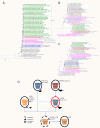A new piece in the puzzle of the novel avian-origin influenza A (H7N9) virus
- PMID: 24160334
- PMCID: PMC4016609
- DOI: 10.1186/1745-6150-8-26
A new piece in the puzzle of the novel avian-origin influenza A (H7N9) virus
Abstract
Using phylogenetic analysis on newly available sequences, we characterize A/chicken/Jiangsu/RD5/2013(H10N9) as currently closest precursor strain for the NA segment in the novel avian-origin H7N9 virus responsible for an outbreak in China. We also show that the internal segments of this precursor strain are closely related to those of the presumed precursor for the HA segment, A/duck/Zhejiang/12/2011(H7N3), which indicates that the sources of both HA and NA donors for the reassortant virus are of regional and not migratory-bird origin and highlights the role of chicken already in the early reassortment events.
Figures

References
-
- Gao R, Cao B, Hu Y, Feng Z, Wang D, Hu W, Chen J, Jie Z, Qiu H, Xu K, Xu X, Lu H, Zhu W, Gao Z, Xiang N, Shen Y, He Z, Gu Y, Zhang Z, Yang Y, Zhao X, Zhou L, Li X, Zou S, Zhang Y, Li X, Yang L, Guo J, Dong J, Li Q. et al.Human infection with a novel avian-origin influenza A (H7N9) virus. N Engl J Med. 2013;8:1888–1897. doi: 10.1056/NEJMoa1304459. - DOI - PubMed
-
- Liu D, Shi W, Shi Y, Wang D, Xiao H, Li W, Bi Y, Wu Y, Li X, Yan J, Liu W, Zhao G, Yang W, Wang Y, Ma J, Shu Y, Lei F, Gao GF. Origin and diversity of novel avian influenza A H7N9 viruses causing human infection: phylogenetic, structural, and coalescent analyses. Lancet. 2013;8:1926–1932. doi: 10.1016/S0140-6736(13)60938-1. - DOI - PubMed
-
- Lam TT-Y, Wang J, Shen Y, Zhou B, Duan L, Cheung C-L, Ma C, Lycett SJ, Leung CY-H, Chen X, Li L, Hong W, Chai Y, Zhou L, Liang H, Ou Z, Liu Y, Farooqui A, Kelvin DJ, Poon LLM, Smith DK, Pybus OG, Leung GM, Shu Y, Webster RG, Webby RJ, Peiris JSM, Rambaut A, Zhu H, Guan Y. The genesis and source of the H7N9 influenza viruses causing human infections in China. Nature. 2013;8:241–244. doi: 10.1038/nature12515. - DOI - PMC - PubMed
Publication types
MeSH terms
Associated data
- Actions
- Actions
- Actions
- Actions
- Actions
- Actions
- Actions
- Actions
LinkOut - more resources
Full Text Sources
Other Literature Sources
Medical

